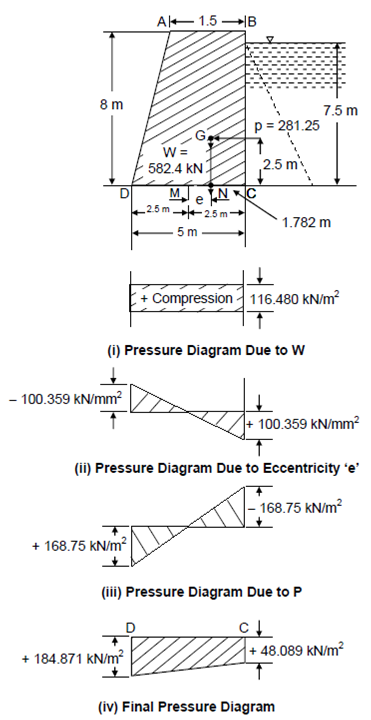Example of Stability of Retaining Walls:
A masonry dam 8 m high is 1.5 m wide at the top and 5 m wide at the base. It retains water to a depth of 7.5m. A water face of the dam is vertical. Find out the maximum and minimum stresses at the base. The weight of the masonry is 22.4 kN/m3.
Solution
Consider 1 m width of the dam (Figure).

Figure
Weight of masonry, W = (1.5 + 5.0)/2× 8.0 × 22.4 = 582.4 kN
Its line of action meet the base DC at N here NC is
NC = x¯ = a2+ ab + b2/3(a + b) = 1.52 + 1.5 × 5 + 52/3 (1.5 + 5) = 1.782 m
∴ Eccentricity, e = MN = MC - x¯ = 2.5 - 1.782 = 0.718 m
The horizontal water pressure P is
P = Wh2/2 = 10 × (7.5)2/2= 281.25 kN
and it acts at a height of 7.5/3 = 2.5 m above the base DC.
∴ (a) Pressure due to weight W is
p1 = W/b = 582.4/5 = 116.48 kN/m2
and is uniform at the base DC.
(b) Pressure because of the eccentricity of weight W is
p2 = ± 6We/b2 = ± 6 × 582.4 × 0.718/52 = ± 100.359 kN/mm2
It varies from a tensile stress - 100.359 kN/m2 at D to a compressive Stress + 100.359 kN/m2 at C at base DC.
(c) Pressure because of the moment of the horizontal water pressure p is
p3 = ± 2 ph/b2 = ± 2 × 281.25 × 7.5/52 = ± 168.750 kN/m2
which varies from a compressive stress at D to tensile at C. The final pressure diagram is shown in Figure 5(iv) as an algebraic sum of p1, p2, p3 and is 184.871 kN/m2 (comp.) at D to 48.089 kN/m2 (comp.) at C.